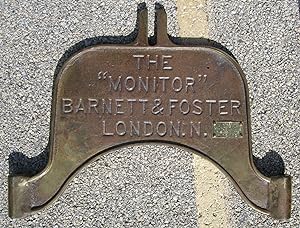Descripción
An amazing chunk of brass advertising from an antique bottling machine measuring approximately 21 x 26 1/2 inches. Estimated to be turn of the 19th century. Last origin was the metro Chicago area. Thanks for looking.Barnett & Foster, (1850 or 1858-1997): London, England, Occurs on 7 bottles, Show distribution map of bottles with the Barnett & Foster mark Put bottles made by Barnett & Foster on a shelf Appears on soda bottles. This company manufactured diving apparatus and branched into bottling supplies. Operated the Niagara Works a bottling equipment and supply house. The company became a division of Borthwicks. The Barnett & Foster division moved from London to Wellingborough in 1968 and was acquired by Danisco in 1997. The markings appear on the reverse heel of the bottle. Source:sodasandbeersdotcom Maker of bottling machinery and of essences for soft drinks, etc, of Niagara Works, Eagle Wharf Road, London N, and Queensbridge Rd, London E8 ?ú 1850 (or 1858) Company established. ?ú 1894 Antwerp Exhibition. Awarded Diploma of Honour for Machinery and Machine Tools. [1] ?ú 1894 Brewer ??s Exhibition. Equipment for aerated waters. [2] ?ú 1898 Absorbed Galloway Brothers (of Bolton). ?ú 1914 Engineers, manufacturing chemists, suppliers of machinery ingredients and general supplies to the bottling trades, manufacturers of diving apparatus, bottles and boxes, ice and refrigerating machinery. Employees 350. [3] ?ú By 1930 2 of the partners were also directors of Bratby and Hinchliffe ?ú 1934 Company incorporated to acquire the partnership of Barnett and Foster. ?ú 1943 Started making "Nutritive syrup" to Ministry of Food specification ?ú 1950 Acquired by Barfos LtdAmerican Heritage: The Bubble Works Richard F. Snow Spring 1987 | Volume 2, Issue 3 Marty Cohen rings the doorbell of my apartment at seven in the morning every Wednesday, the day his route takes him to the Upper West Side of Manhattan. He is a husky fellow, built like an iceman, and he has to be: like the iceman ??s, his job involves carrying heavy things into people ??s homes. And like the iceman ??s, his job is nearly extinct. Every trip, Marty drops off a case of ten full seltzer-water bottles and picks up ten empties. The bottles pretty much tell the story of the industry. All are old, some are ancient, and most have the names of their original owners etched on their sides: Jacob Taleisnikow, Harry Chpitz, Louis Fridberg, each marked ??Bklyn, ? for this was once a big industry in Brooklyn. But others are from the Bronx and Manhattan, and every now and then a bottle turns up from the Schmeltzer Brothers in Pottstown, Pennsylvania, and once in a while from what one would have thought to be the seltzerless reaches of Michigan. They ??re Marty ??s now because the companies that commissioned them have all gone out of business, the indestructible bottles outliving owner after owner. Fifty years ago in New York there were six hundred dealers being supplied by forty bottling shops. Ten years ago there were three hundred seltzer men and eight shops. Today three shops meet the demand. One of the survivors is Lou Beverage Distributors, Inc., on Ingraham Street in a work-worn section of industrial Brooklyn. Lou Weinstein has retired and left the day-to-day running of the business to his son, but he is on hand this cool, gray September day to talk about his seltzer-bottling machines. There are two of them, each bearing a big nameplate that reads ??The ??Monitor ?? Barnett & Foster, London N. ? It is perhaps fitting that they were built in England, since carbonated beverages began with the great British chemist Joseph Priestley ??s attempts to duplicate the effervescent waters of European spas (among them the Prussian village of Nieder Selters, which would give the beverage its name). Priestley charged water with ??fixed air ? ??the carbon dioxide that, under pressure, gives soft drinks their sparkle ??and published his findings in 1772. By the early years of. N° de ref. del artículo 63907-1732
Contactar al vendedor
Denunciar este artículo
![]()




